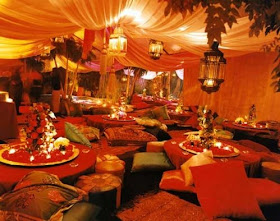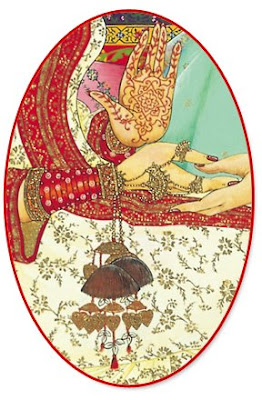 The morning before the actual wedding ceremony, the bride's maternal uncle and aunt come to the bride's house loaded with gifts for the family and the bride:)
The morning before the actual wedding ceremony, the bride's maternal uncle and aunt come to the bride's house loaded with gifts for the family and the bride:)It is now that the bride is made to wear the traditional chooda (a set of 21 white and red bangles, an important symbol for a newly wed punjabi bride) by her maternal uncle and aunt. the bride is not supposed to look at the chooda before or during the process is on. All family members touch the chooda to bless the bride and sing traditional songs. in olden times the chooda used to be made out of ivory but now it is made in plastic.
 After the chooda has been worn, the bride's family ties the kaliras on each hand to a bangle.
After the chooda has been worn, the bride's family ties the kaliras on each hand to a bangle.Kaliras are traditionally umbrella shaped ornaments made in thin gold or silver sheets. Some relatives even tie small silver boxes, toe rings etc onto the kaliras. These ornaments signify blessings and good wishes. From now on the bride has to wear these till the end of the wedding ceremonies. Some jokingly say that the kaliras are tied so that the bride may rest before the wedding day as working with the kaliras on becomes very difficult especially if you have a big extended family (which is the case for me;).

 The bride then shakes the kaliras on the heads of the unmarried girls of the family and the popular saying is that...the lucky one on whom a part of the kalira falls will be the one getting married next!!
The bride then shakes the kaliras on the heads of the unmarried girls of the family and the popular saying is that...the lucky one on whom a part of the kalira falls will be the one getting married next!! i like the traditional golden kaliras the best...they look so pretty...and this photograph above has always been one of my favourite frames in any wedding album. In India girls are often called Lakshmi (the goddess of wealth and prosperity)..and so when the lakshmi of the house leaves to go and be with her husband, she ensures that her maternal house remains prosperous by throwing rice puffs which are symbolic of food and wealth :)
i like the traditional golden kaliras the best...they look so pretty...and this photograph above has always been one of my favourite frames in any wedding album. In India girls are often called Lakshmi (the goddess of wealth and prosperity)..and so when the lakshmi of the house leaves to go and be with her husband, she ensures that her maternal house remains prosperous by throwing rice puffs which are symbolic of food and wealth :)i love this custom...don't you think its sweet?
all pics from rob and lauren photography, maharani weddings and theweddingbee







































